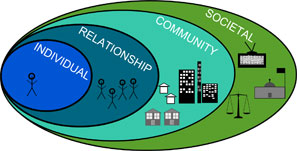Sexual Violence and Interpersonal Violence are intrinsically connected to social norms and cultural practices that endanger the safety, health, and wellbeing of our community at large. Due to this reality, sexual violence is understood to be a social injustice and a public health crisis. In 1985, sexual violence became officially recognized as a public health problem (WHO), and many theories and prevention strategies have been organized around this accreditation. The World Health Organization (WHO) and Centers for Disease Control and Prevention (CDC) recognize sexual violence to be a public health problem, and the St. Olaf College Consent and Sexual Respect Initiative is committed to implementing prevention programming and providing resources in accordance with public health recommendations and evidence-based intervention strategies.
The Socioecological Model and the Levels of Prevention Model are methods utilized within the public health sector to understand and respond to public health problems, including sexual violence. The Levels of Prevention Model organizes prevention into three distinct categories that each have a separate intervention focus and approach. These levels of prevention are labeled as Primary Prevention, Secondary Prevention, and Tertiary Prevention.
In sexual violence prevention work, a model of behavior change is the social-ecological model.

The social-ecological model is used because sexual violence is complex. People perpetrate sexual assault for a wide variety of reasons and as a result of many different influences on their lives. The social-ecological model provides a framework for understanding those different influences and their relationship to one another.
The influences in life that cause sexual violence are spread throughout different contexts—it’s not just violence in movies, or having sexist attitudes or beliefs. Many things influence perpetration and victimization of sexual violence.
Therefore preventing sexual violence is more complicated than other public health issues. This is why it is important our prevention efforts reach people on multiple levels of the social-ecological model.
| Socio Ecological Model (chart adapted from Washington Coalition of Sexual Assault Programs) | |||
| Level | Influences | Strategy | Prevention Activity Examples |
| Individual | Factors that increase risk such as biological, personal history, alcohol/drug use, attitudes/beliefs that support sexual violence | Promote attitudes, beliefs and behaviors that support equality, respect and non-violence | Educational sessions that encourage individuals to challenge violence, sexism, racism, homophobia, etc. and comprehensive sexuality curricula that promote healthy sexual relationships that are mutually beneficial to both partners. |
| Relationship | Relationships with peers, intimate partners, family members can influence risk for sexual violence. | Promote healthy communication and behaviors by modeling relationships. | Peer or bystander projects that gives youth tools to change the climate of their social circles by rejecting or intervening when they hear or witness behaviors that support violence, sexism, etc. |
| Community | Factors that increase risk based on community and social environments, including an individual’s relationships with schools, workplaces, neighborhoods. | Promote a climate in the community that by targeting processes or policies. | Launching a social marketing campaign on a college campus that promotes consent and safe practices in sexual relationships. Corresponding workgroup that proposes a student bill of sexual rights. |
| Societal | Larger, macro-level factors that influence sexual violence such as gender inequality, religious or cultural belief systems, societal norms, and policies that create gaps in service. | Promote social norms, policies and laws that support sexual freedom, rights and healthy relationships. | Targeting law makers to increase funding for prevention activities in schools. Creating a program that provides them with reasons to promote prevention: lifelong effects of violence on the community, cost to society, etc. |
- Primary prevention initiatives are directed at preventing the development of disease or injury. Examples of primary prevention within the context of sexual violence include comprehensive sexual education, mandatory bystander intervention training, and healthy relationship coaching. These measures operate as a means of preventing sexual misconduct and promoting sexual autonomy and healthy practices before misconduct has occurred. Prevention at this level is often general and directed at diverse audiences.
- Secondary prevention measures focus on the immediate response after violence or injury has occurred and address short-term repercussions. Examples of secondary prevention include crisis intervention, medical assistance (including SANE exams), and advocacy support.
- Tertiary prevention programs are aimed at mitigating the long-term effects of violence or injury. Examples of tertiary prevention include counseling, support groups, and self-defense classes, etc.. Tertiary care is specified towards an individual’s health needs.
Risk & Protective Factors
Risk factors are a set of behaviors and/or conditions associated with a greater likelihood of sexual violence perpetration, and protective factors are behaviors and/or conditions that may reduce or buffer against the risk for sexual violence perpetration. These are contributing factors and might not be direct causes. Not everyone impacted by risk factors goes on to use violence against others. This infographic highlights the connections between risk and protective factors and social determinants of health at the various levels of the social ecology and can be used to link sexual violence prevention with anti-oppression and related public health issues in order to create more effective change. Click on this Risk & Protective image for more information.
You must be logged in to post a comment.